How to Introduce and Practice Fluency with a Fluency Boot Camp
Break up the mid-winter slump and bring a Fluency Boot Camp into your classroom!
What is a Fluency Boot Camp?
No… you will not be shipping your students off (sorry), nor will students have to march around the room (your choice), but I can guarantee that your students’ brains will be sweating as they participate in the classroom fluency camp you create!
Just like any boot camp, students will build confidence through practice and drills. You can organize it for just one day, or you can set it up to last a full-week or month! Keep in mind, after just one day, students will start melting-away their non-fluent reading habits… and by the end of the week or month, students will be on their way to becoming confident, fluent readers! 🙂
Are you sold on the idea yet?
How to Organize Your Fluency Boot Camp
Fluency Boot Camp can be modified and customized for pretty much any grade-level and classroom situation. You can set up your Fluency Boot Camp the way YOU want, in any form or style. Consider including overviews of fluency components, practice “drills,” and reinforcement activities. I will be sharing many resources to help you get started, but you may need to do a little exploring and research to create your program to meet the needs of your students. One boot camp does NOT fit all!
Want a copy of this planning page? This page is FREE for my email subscribers. If you’d like to download this page, click here to subscribe (you will get the password via email). You will also receive exclusive access to my entire growing collection of free literacy resources! (If you’re already a subscriber, you may download the resource HERE.)
Fluency Boot Camp Materials
Necessary Materials:
- One group of willing soldiers… I mean, students!
- Reading passages
- Poetry
- Readers Theater Scripts
- Word/Phrase Cards
- Fluency Graphs
- Microphone (for audio recording)
- Clock/Stopwatches
NOTE: Digital stopwatches are preferred, however you can use an ordinary wall clock or hour-glass board game timers if necessary. If you’re looking to purchase stop watches, I would highly recommend ones that can count up and down. There are some great kitchen timers that do this! If you have access to a few computers, there are online stop watches too!
Optional (Fun) Materials:
- Whistles (ha!)
- Drill Sergeant Hat/Button (for the teacher, of course!)
- T-Shirts (builds-up community and team play when all students are dressed in the same “uniform”!)
- Survival Packs (including snacks & tissues for their sweating brains!)
What is Fluency?
Let’s start with what fluency is…
Fluency is the ability to read smoothly and automatically, with expression and attention to punctuation.
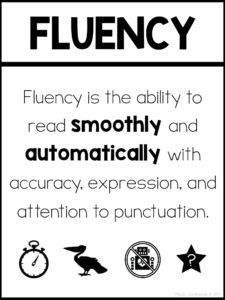
That’s a simple definition, but we really could expand it to include much more (i.e., prosody, melody, etc.). Do keep in mind, that accuracy plays a huge part in fluency, and students need to ask themselves the big three questions to monitor their reading: “Does it look right? Does it sound right? Does it make sense?” Often, struggling readers have a hard time with fluency due to their self-monitoring and decoding difficulties (which can be addressed in small group intervention groups, separate from Fluency Boot Camp), and as a result their comprehension is greatly affected. Decoding, comprehension, and fluency all go hand-in-hand, so when one piece of the puzzle is weak, the other pieces may suffer!
Struggling readers are not the only ones who need extra support with fluency though! I have many on and above grade-level readers who have difficulty with fluency too. A few of my best readers have wonderful decoding and comprehension skills but are slow and methodical readers. Some of my higher readers read so fast that they stumble over their words or miscue left and right. Fluency is all about finding the “just right” balance of pace, phrasing, expression, and attention to punctuation (with accuracy to tie it all together!). It is an essential literacy skill to develop, which is why a Fluency Boot Camp is the perfect “intervention” for any classroom.
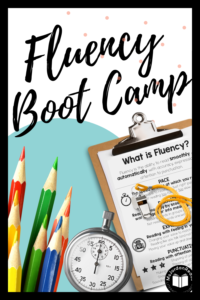
Getting Started
So are you ready to develop a Fluency Boot Camp that will be beneficial for ALL the students in your classroom?
Overview
I would recommend starting the first day with an overview of the major fluency components: Pace, Phrasing, Expression, and Punctuation. Each day (or week!) you can get into the “nitty gritty” of each component, with explicit modeling and opportunities for student practice. I would also send home a letter explaining Fluency Boot Camp with a fluency reference sheet attached so they can provide reinforcement as well. Perhaps you’ll want to tie in take-home work with the fluency activities, or perhaps you send home a book-in-a-bag and you’ll want the students to practice fluency with those!
(Grab this FREE student fluency resource from my TpT shop or in my Fluency Boot Camp Sampler!)
Online Tools & Resources:
Fluency Folders
Before you go into the activities, I would create a Fluency Folder for your students to keep all their Fluency Boot Camp materials! The overview reference sheet can be page 1!
NOTE: For an easy-to-make folder, I usually laminate a large piece of construction paper and then fold it in half to create a colorful (cheap) folder that lasts. I punch 3 holes in it and use paper clasps to keep the papers in the folder. All my fluency activity sheets, graphs, reflections are 3-hole punched so the materials can go right into the folder.
These folder labels are free for my email subscribers. Subscribe here or using the form below. (If you’re already a subscriber, you may download the resource HERE.)
The “Nitty Gritty” Fluency Activities
As I said in the getting started section, I would begin with an overview and then go into a full day (or week!) for each component. You can pick and choose which activities you integrate, so pick ones that will fit the learning styles and needs of your students. For each activity, make sure you model, model, MODEL! Whether it’s an independent activity or a partner one, students need to SEE what the activity looks like and what the expectations are for them. These activities are ones that are more effective with repetition, so be sure to implement them a few times during the camp. You may also want to bring them back later in the year for extra review and reinforcement! We all know students benefit from extra practice!
PACE
Pace = the speed in which you read
- The goal is to read at a “just right” pace
- Reading not too fast and not too slow
Speed Drills — Speed drills build fluency because they help students quickly recognize letters, words, word families, common syllables, and spelling patterns in multi-syllabic words (depending on your grade-level). Students love trying to beat their score, especially those who have an extra competitive gene in them! I typically do 1-minute partner drills and have the students graph their progress for each attempt!
Reading Passages (Cold/Hot Reads) — Cold and hot reads are perfect for students to see their progress in their reading pace after practice! A “Cold Read” is when a student reads a passage for the very first time (no practice). A “Hot Read” is when the students are warmed-up and have practiced the passage a few times. Students can time themselves or work with a partner! I have my students set a goal for themselves… typically it’s words per minute (wpm) range for themselves, so they have a number to shoot for! They color this range in or block it off with a highlighter on their graphs. (Grab a FREE sample graph and calculation reference sheet for Cold/Hot reads from my Fluency Boot Camp Sampler!)
Online Tools & Resources:
Speed Drills:
- Word List Generator (Intervention Central)
- Florida Center for Reading Research (Word Parts & Words)
- Fluency Speed Drills (MsJordanReads)
Reading Passages:
- Reading Fluency Passage Generator (Intervention Central)
- Fluency A-Z (membership required)
PHRASING
Phrasing = Chunking the words together into meaningful phrases
- Reading in phrases and not reading words one.word.at.a.time.
Phrases are chunks of meaningful text and I usually start this day by introducing the three main types of phrases: Who, Did What, and Where/When/Add-On. I model different phrases and how to put them together in a meaningful sequence to make sentences. Students can then practice creating their own phrases using “Connect-a-Dot Sentences.” (Grab a FREE Connect-a-Dot phrasing practice page from my Fluency Boot Camp Sampler!)
Additionally, students can also practice phrasing by using phrase-cued text. Marking the end of phrases with a slash / or the end of lines with //. I also have my students “scoop” their words by underlining or drawing curved scoop lines under the words in each phrase (see student reference sheet above for an example). They then can trace the scoops with their fingers during reading for the first few practice reads. Eventually they should remove the finger scooping so it can become an automatic habit inside their heads!
NOTE: It’s important to make the connection between punctuation and phrasing here. Commas and periods are natural phrase markers and students should use these marks to help them read in meaningful phrases.
Online Tools & Resources:
- Florida Center for Reading Research (Phrases)
- Phrase-Cued Text Generator (Intervention Central)
EXPRESSION
Expression= Reading with feeling in your voice
- Changing your voice to match a character
- Reading like you would speak (and not like a robot!)
- Moving your voice up and down
Readers Theater and Poetry are two great ways for students to practice expression (and tie in the components of fluency as well). For both types of text, students can apply expression and practice putting feeling and emotion into their reading!
Readers Theater is a reading play, of sorts. There is no scenery or intricate costumes involved, just students and reading scripts. I like to use puppets, hats, and props but it is not necessary. Students are assigned parts and can practice their lines independently or with their group. A performance can take place for students to “show-off” their amazing expression!
Poetry reading is a little less involved than Readers Theater activities, but just as effective! During regular instruction, you can integrate all sorts of word work and mini-lessons on poetry elements, but sometimes it’s perfect for just plain ole’ fluency! Students especially love reading silly poems , so this is a time to break out the Shel Silverstein and Kenn Nesbitt. As long as students can control their giggles, they’ll love having time during Fluency Boot Camp to explore and read these poems… with fluency, of course!
NOTE: Practice is key with both, and students should read each repeatedly to build up good fluency.
Online Tools & Resources:
Readers Theater Scripts:
- PBS Kids
- Timeless Teacher Stuff
- Scholastic Readers Theater Props (free printable hats, glasses, and props!)
- Fluency A-Z (membership required)
Poetry:
NOTE: A great poetry book for your classroom is Partner Poems for Building Fluency. It is listed for grades 4-6, but I’ve used some of them with my 2nd and 3rd graders as well. You can download sample pages here! A younger version of Partner Poems for Building Fluency for Grades 2-4 is available on Amazon, but I’ve haven’t check it out yet!
Looking for more partner poetry?! Check out some of my own original partner poems here!
PUNCTUATION
Punctuation = Reading with attention to punctuation
- stopping and taking breaths at periods . . .
- pausing at commas , , ,
- making your voice go up for question marks ? ? ?
- showing excitement for exclamation points ! ! !
- using “quotations” to change voice for characters
Writing with punctuation is often a chore for students, but reading with punctuation can be fun! Tying right in with expression, students can practice using the different kinds of punctuation when they read. First I model what reading sounds like without punctuation. By the end I’m panting for breath and ready to pass out, since I didn’t pause once. Students get a kick out of this but it definitely proves a point. Sometimes I’ll give them a punctuation-less passage to try on their own. They can even “fix it up” after to make it sound right, putting in the periods, commas, quotations marks, etc.
I also love giving students a sentence like, “I love french fries” and having them read it three different ways:
I love french fries.
I love french fries?
I love french fries!
Students can practice making and reading their own sentences three different ways with a partner or small group.
Another activity to try, is to have punctuation cards for students to hold up while a partner reads a short poem or a passage. As students HEAR punctuation, they hold up the appropriate card to show they know which one was used. Students have to be careful readers when they read the poem/passage, and careful listeners when it’s their turn to hold the cards!
Online Tools & Resources:
- Fluency with Punctuation (Reading Resource)
- National Punctuation Day
- Reading Punctuation is Essential for Fluency (Smekens Education Solutions)
Reflecting & Celebrating
Don’t forget to celebrate student success (and survival!). Download these stickers for students to wear, and a printable certificate for students to take home! (Note: You can print it as a full sheet or two to a page under print options!)
My email subscribers can download these stickers and certificate for free. Click here to subscribe or sign up below. (If you’re already a subscriber, you may download the resource HERE.)
You can even have an awards ceremony to hand out the certificates. Perhaps the students can vote on the students in the class who exemplified “Most Improved” or “Best Pace,” etc. Just be sure to make it fair and include all students somehow. We don’t want any tears in this boot camp!
Also, a great follow-up to Fluency Boot Camp would be for students to reflect on their fluency progress. Students should think about their strengths, weaknesses, and what they can improve upon. Students can keep their self-reflections in their Fluency Folders to set goals and monitor their own progress throughout Fluency Boot Camp, or perhaps even the year! (Download a FREE Student Self-Assessment page in my Fluency Boot Camp Sampler!)
Integrating Technology
Audio Recording — Students can record their before and after reading of a passage. They listen to both recordings and then reflect and set goals for themselves for the next time they read! (This is VERY powerful for students to listen to their own reading!)
Online Tools & Resources:
- Audacity(free audio recorder)
- Pod-o-matic
- RAZ-Kids (membership required)
Additional Fluency Resources
Related Blog Posts:
- Classroom Tips for Implementing Successful Fluency Interventions
- 5 Easy and Successful Ways to Improve Reading Fluency in Your Classroom
Fluency Programs:
- HELPS (FREE comprehensive fluency program with many great resource links!)
Professional Fluency Resources:
- Reading Resource
- Intervention Central
- Florida Center for Reading Research (NOTE: For grade-specific fluency resources from from the Florida Center for Reading Research, click on these links: K-1, 2-3, 4-5 and then scroll down to the “Fluency” section!)
Professional Fluency Books:
- The Fluent Reader (2nd Edition): Oral & Silent Reading Strategies for Building Fluency, Word Recognition & Comprehension, by Tim Rasinski
- Fluency Instruction: Research-Based Best Practices, by Tim Rasinski
- Readers Theater for Building Fluency: Strategies and Scripts for Making the Most of This Highly Effective, Motivating, and Research-Based Approach to Oral Reading (Teaching Strategies, Grades 3-6), by Worthy Jo
- Building Fluency: Lessons and Strategies for Reading Success, by Wiley Blevins
Want to start tomorrow but don’t have time to put one together?
If you are interested in bringing a Fluency Boot Camp into your classroom but don’t have the time to put together your own binder of materials, consider checking out my “Fluency Boot Camp” classroom resource! This product has 90+ pages of extra posters, activities, forms, and student materials, and contains everything you need to get started with fluency instruction. Download a FREE sample below!
An additional product, with 50 pages of supplemental Word Lists and Speed Drill Materials, can be found here!
Subscribe for a FREE Fluency Boot Camp Sampler Pack!
I'd Like to Subscribe & Receive the FREE Fluency Boot Camp Sampler!

Hope you’ve found these resources helpful! Now it’s time to “Fall in Line!” and find the program that works best for you! 🙂 I would love to see pictures or hear stories “from the trenches” about how Fluency Boot Camp worked out in your classroom.
—
Happy Teaching!
**This post contains affiliate links. Click HERE to learn what that means!
(NOTE: The resources on this blog are ones that I have used with my students grades 2-5. Many of the activities can be modified for younger students but not all may be appropriate. The ideas shared are just a starting point and not an exhaustive list. With that in mind, I would be happy to explore some options for your unique setting if you just email me or leave a comment below!)

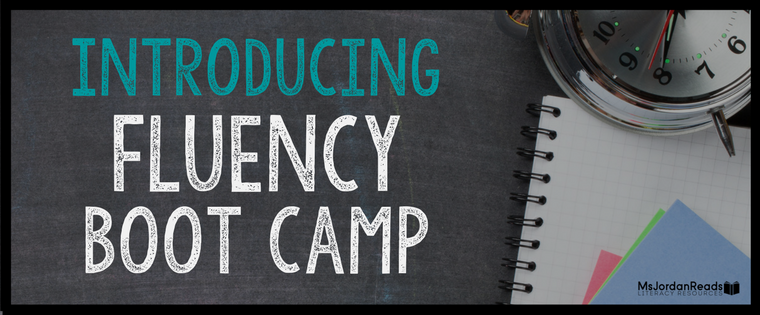
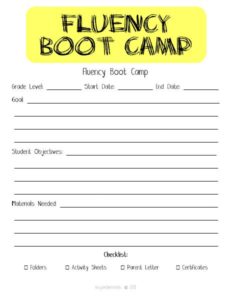




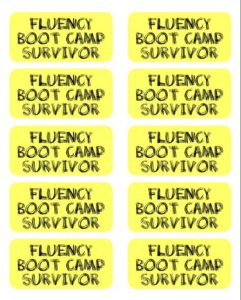
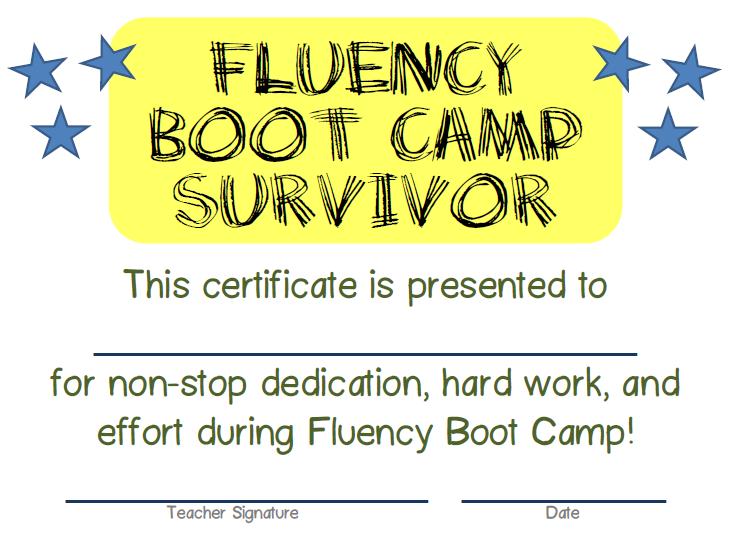
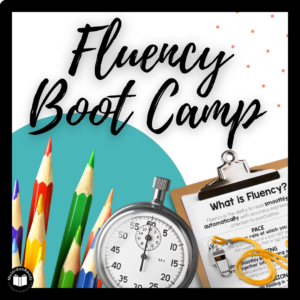
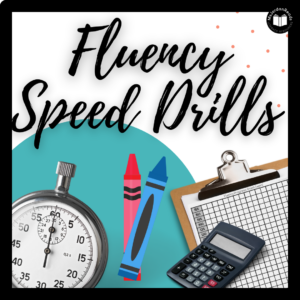

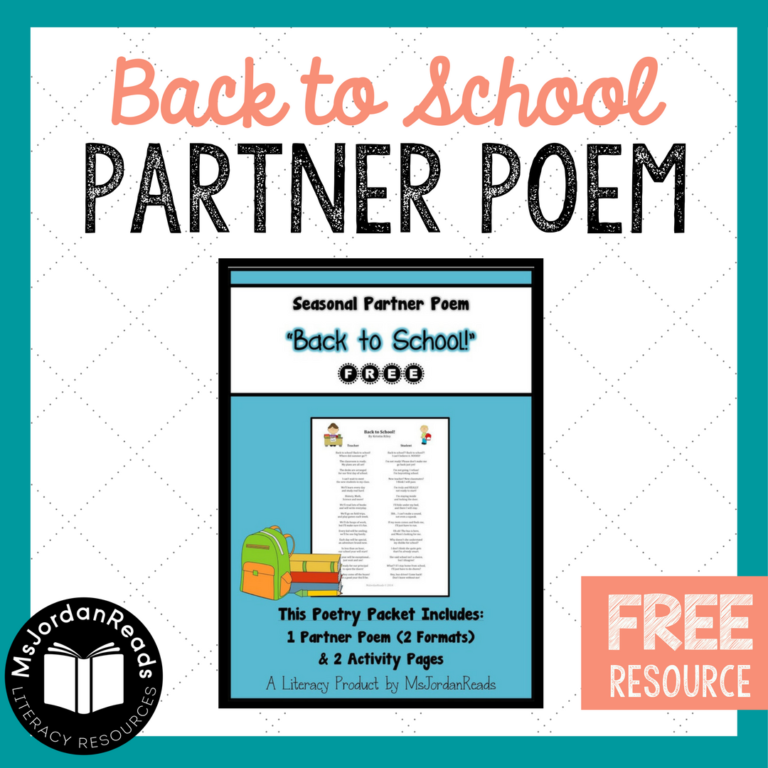
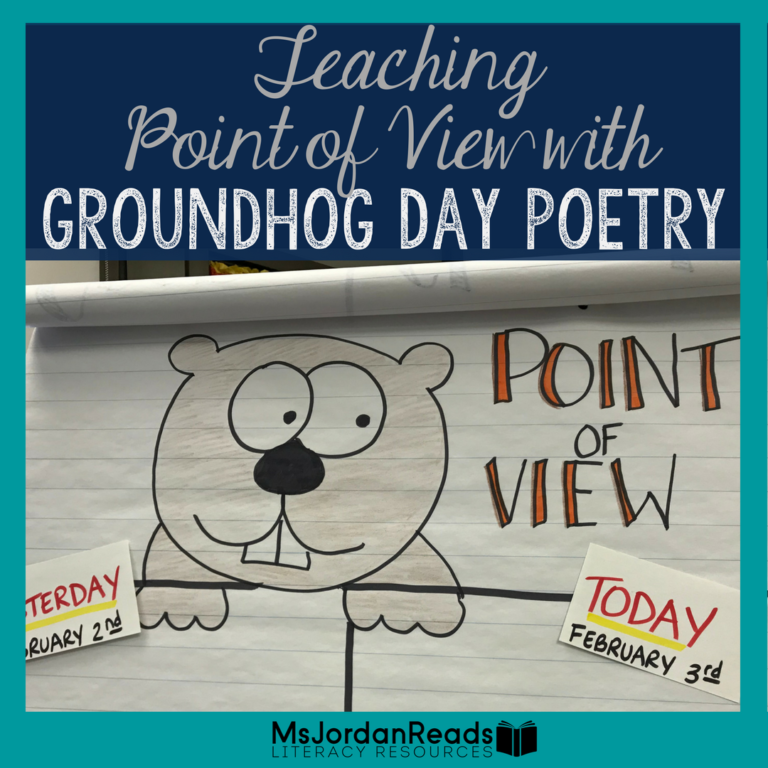
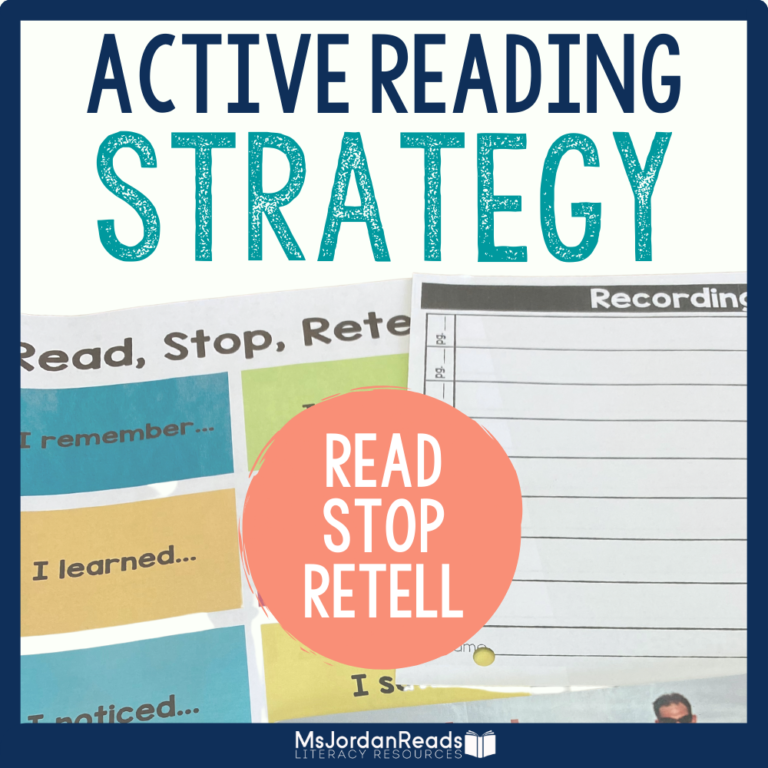
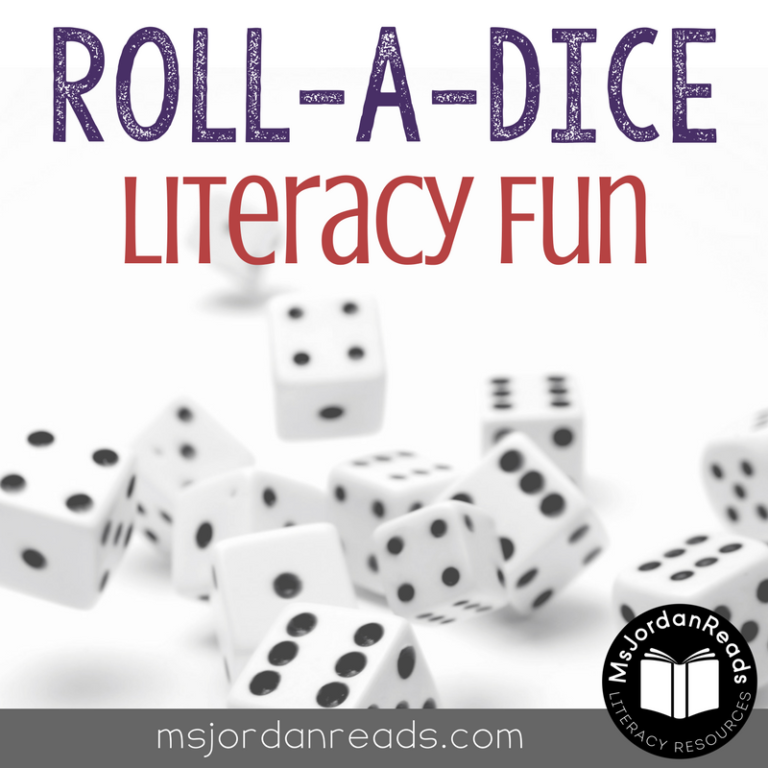
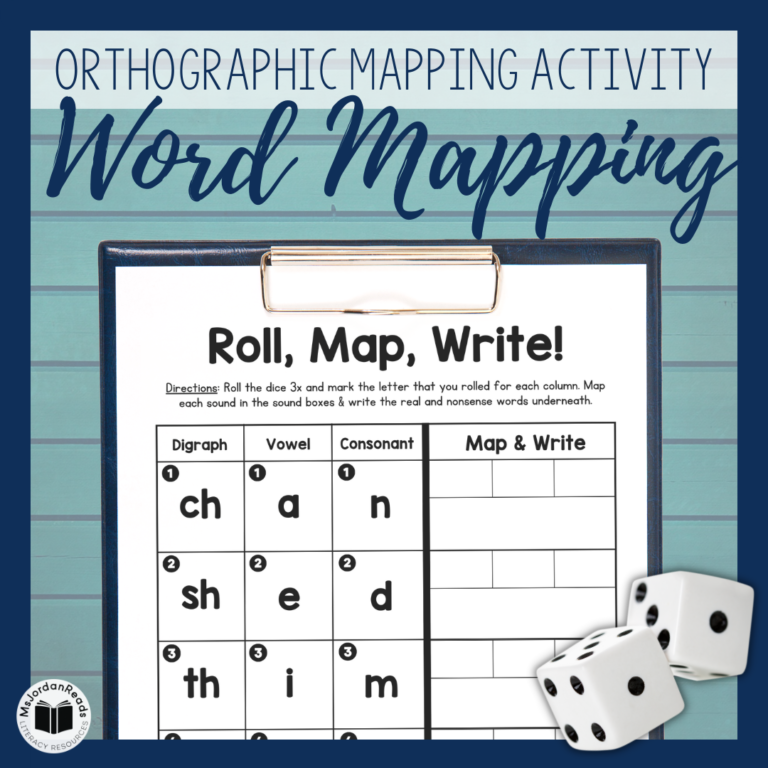
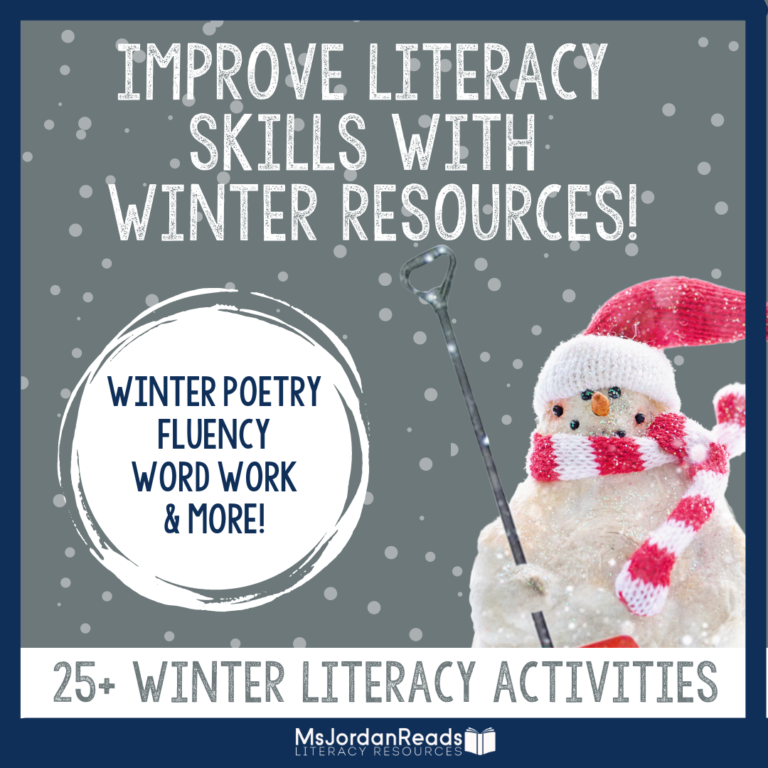
I LOVE this!!! Thank you so much for sharing. This works perfectly into my Fluency intervention classes.
Great to hear! Let me know how your students like it! 🙂
Kristin
WOW! What a great idea, and I love how you shared it. Thank-you!
Jen
Runde’s Room
Thank you for visiting and checking out my blog! Hope you find the ideas and resources helpful. Let me know if I can answer any questions! 🙂
Kristin
As I was going through every piece and link that you have provided, I noticed that many of the activities were geared towards upper elementary (Gr 4-5) outside of the sight words and syllable practice. Do you have any resources from the Florida site or elsewhere that could be used for 2nd graders? I really like this idea and would love to do it with my students, but want them to feel some success, not frustration because the activities are too difficult. Looking forward to your reply 🙂
Karyn,
Thank you for your interest! In response to your comment I added a few more links for K-2 classrooms. The FCRR website for Grades 2-3 has many ideas for early primary classrooms.
Here are a few links I added:
Article:
Increasing Reading Fluency in Beginning Readers
Printables:
Scholastic Poetry Printables
Books:
Partner Poems for Building Fluency – Grades 4-6 (with a sample here) – I use these grades 2-5, some are easy enough for my 2nd graders!
Partner Poems for Building Fluency – Grades 2-5 – Younger version I haven’t tried yet!
Below are a few more links I didn’t add to my blog post, but may be helpful:
Wiki with Great Fluency Resources:
http://westmaple.wikis.birmingham.k12.mi.us/2nd+%26+3rd+Reading (Grades 2/3)
http://westmaple.wikis.birmingham.k12.mi.us/K+%26+1st+Reading (Grades K/1)
Partner Fluency for Primary Students:
http://coedpages.uncc.edu/bric/fluencypartnerpracticeprogram.pdf (sample passages included)
I do think many of the resources I mentioned and shared in my blog post can be used for second grade though. I use Connect-a-Dot Sentences, Word/Phrase Drills, Scooping Words, Simple Sentences Read 3 ways (using different punctuation), Accuracy Word Pairs, Poetry, Readers Theater, and Short Reading Passages. Podcasting works for early grades too!
If you still don’t think any of those idea will work, I have a few additional ones in my Teachers Pay Teachers “Fluency Boot Camp” product. You can download a the thumbnail preview of my “Fluency Boot Camp” product for free to preview the 70 pages that are in it to see if it’s worth the purchase! Many of the activities I use with my 2nd graders!
Hope this helps! Let me know if you have any other questions! You can email me at msjordanreads@gmail.com.
Kristin
Wow, this is awesome!! Is this for a specific grade? I am a new follower. Come check out my blog when you have a chance.
April
Wolfelicious
April,
With the resources I shared, I would say grades 2-6 but you can definitely modify it for ANY grade level. I just added a few more links for early primary classrooms. See my other comments!
Kristin
(PS. I just checked out your blog! Wonderful ideas and resources!)
Thanks for sharing this! im going to try it out with my third graders!
Wonderful! I would love to hear how it goes! 🙂
I’m so happy I found this. I will probably be home instructing a student this summer where fluency is a problem. I can use this in the summer to help him improve his reading along with his other goals!
I just wanted to say that reading this just gave me the boost I needed. I have begun to feel like I’ve hit a brick wall in planning for my guided reading groups and I just got so excited thinking of the student who will benefit as a result of your ideas. I had been doing fluency with a few of my student in the beginning of the year but it just got boring and tedious, but I know feel excited to spend my day planning this! Thank you so much for the great ideas! I love the idea of the terminology “boot camp” as well, what a great motivator for students!
Thank you for your comment! It’s nice to hear that the ideas I share on my blog are making a difference. I truly hope this Boot Camp idea helps your students and makes a difference for the students who need it! Good luck and let me know if you have any questions along the way. 🙂
Love this! Thanks for sharing. Head over to my new 2nd grade blog if you get a chance. http://secondgradeperks.blogspot.com/
I had to smile at the theme of “Boot Camp.” My students all know I was a sergeant in the Army Reserves, so this will give new meaning to the program.
I just found your blog and love it! I gave you an award. Please come over and get it.
2B Honey Bunch
The Best Endings
Thank you Erika! 🙂
Wow, Wow, Wow! Thank you for all the time and resources. Excited to try with my reading intervention groups.
Thank you, Peg! Please come back and share how it goes! Let me know if you have any questions as you go along!
I’m interested in trying this the week after our state testing which happens to be just befor DIBELS. I’m mtersted in knowing though, how much time each day you spend on the activities or a schedule that you use. Looks like a great think for the kiddos to experience.
Misty,
You can customize It however you want! I know time is always a challenge, but if you’re doing a one-week camp, I would try to dedicate 45-60 minutes a day! Students can rotate through centers or you can set it up as a choice board (eg. complete this many activities by the end of the week, etc.). You may even want to do fluency conferences or coaching with your struggling readers during this time. Start with mini lessons and then have students try it out independently. You can even do two 10 min mini-lessons and two 20 minute independent work blocks.
It’s completely up to you! 🙂 Hope this helps to answer your question!
—
Kristin
Thanks a million- I purchased the pack on TPT today- cant wait to get it all going. I think it will really help!
Let me know how it goes or if I can answer any more questions! 🙂
I love this idea! Thank you so much for sharing. I’m taking a grad class in fluency right now so your post has definitely given me further insight.
We are winding down the school year and I have been looking for something for my kindergarten students to do this coming week that would be different. I am going to try bringing this down to their level. Thanks for the ideas!
Hey, Kathy! Hope you’re having a great summer! I would love to hear how the Fluency Boot Camp worked out with your Kindergarteners. I’ve never used it with that grade level, since I teach grades 2-5, but I have many blog followers who would love to hear how you modified it! Please share if you’re willing and you have a few moments this summer. 🙂
—
Kristin
Thank you so much for all these wonderful ideas! I am so excited to start this fall with my own fluency boot camp! Thanks again!
Thank you for your comment, Amy! I’d love to hear how the Fluency Boot Camp works out in your classroom, so please stop by next fall and let us know! Enjoy the rest of your summer! 🙂
—
Kristin
I just read your blog for the first time. I’m a California 4th grade general ed teacher, and I can’t wait to try your fluency ideas. You have an amazing gift! I am now a new follower!
Thank you so much, Margaret! I appreciate you stopping by and checking out my resources. Would love to hear how the fluency ideas work out in your classroom. Please come back and let us know! 🙂 Have a great rest of the summer.
—
Kristin
This was an amazing source of information. I have hunted for a fluency site for a long time. You filled in many gaps for me. Thank you soooo much. I am going to pass this on to others. Can’t wait to use it.
Thank you for stopping by and sharing my blog with others! I appreciate your support and hope to share lots more this summer. Fluency is always a challenge to teach, so I truly enjoy sharing resources that could be helpful to others. Enjoy the rest of your summer!
—
Kristin
What a great resource! I already do much of this, but you have made my work so much easier and expanded my resources. I tutor through a Wilson based program called the Augustine Project. Thank you.
This website is excellent! Exactly what I was looking for.
This is fantastic! I teach special ed and have some boys who are just going to love this! I can’t wait to get started. I hope they are as excited as I am!
Thanks, Amanda! I hope your students enjoy it as much as mine do. I would love to hear how it goes! 🙂
—
Kristin
Very interesting!!! I’m teaching summer school again this year (after taking a few years off). I think this is just the thing to use to help the students continue their skill advancement while shaking it up a bit. In other words, I don’t want their summer school session to simply be a repeat of Aug – May. It will look different, probably feel different, but still hit the very important needed skill focus.
Would it be possible to modify your explanation of what fluency is so that I can put it in my parent newsletter? I would like to share this resource with the parents and have the information fit on a 1/2 page slot in my newsletter. Thanks for any help you can give!
Audrey — I’m not clear about what you need modified or what changes you’re looking for. Do you just need a more concise definition? Please email me at msjordanreads@gmail.com. Thanks! 🙂
Just sent you an email, Thanks for any help you can give